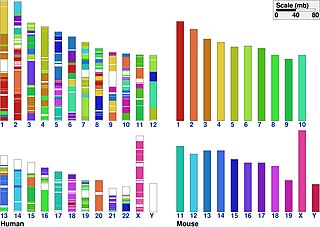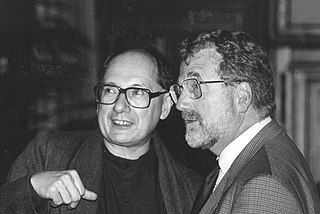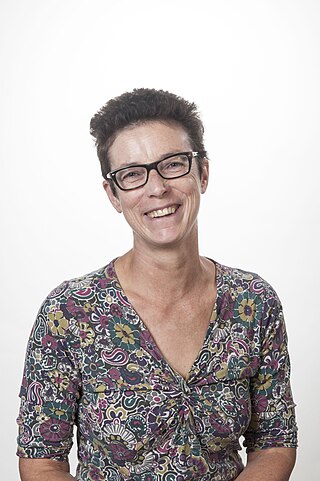Related Research Articles
Gene duplication is a major mechanism through which new genetic material is generated during molecular evolution. It can be defined as any duplication of a region of DNA that contains a gene. Gene duplications can arise as products of several types of errors in DNA replication and repair machinery as well as through fortuitous capture by selfish genetic elements. Common sources of gene duplications include ectopic recombination, retrotransposition event, aneuploidy, polyploidy, and replication slippage.

The John Innes Centre (JIC), located in Norwich, Norfolk, England, is an independent centre for research and training in plant and microbial science founded in 1910. It is a registered charity grant-aided by the Biotechnology and Biological Sciences Research Council (BBSRC), the European Research Council (ERC) and the Bill and Melinda Gates Foundation and is a member of the Norwich Research Park.

A tumour inducing (Ti) plasmid is a plasmid found in pathogenic species of Agrobacterium, including A. tumefaciens, A. rhizogenes, A. rubi and A. vitis.

In genetics, the term synteny refers to two related concepts:

Paleopolyploidy is the result of genome duplications which occurred at least several million years ago (MYA). Such an event could either double the genome of a single species (autopolyploidy) or combine those of two species (allopolyploidy). Because of functional redundancy, genes are rapidly silenced or lost from the duplicated genomes. Most paleopolyploids, through evolutionary time, have lost their polyploid status through a process called diploidization, and are currently considered diploids, e.g., baker's yeast, Arabidopsis thaliana, and perhaps humans.

Common wheat, also known as bread wheat, is a cultivated wheat species. About 95% of wheat produced worldwide is common wheat; it is the most widely grown of all crops and the cereal with the highest monetary yield.

Brachypodium distachyon, commonly called purple false brome or stiff brome, is a grass species native to southern Europe, northern Africa and southwestern Asia east to India. It is related to the major cereal grain species wheat, barley, oats, maize, rice, rye, sorghum, and millet. It has many qualities that make it an excellent model organism for functional genomics research in temperate grasses, cereals, and dedicated biofuel crops such as switchgrass. These attributes include small genome diploid accessions, a series of polyploid accessions, a small physical stature, self-fertility, a short lifecycle, simple growth requirements, and an efficient transformation system. The genome of Brachypodium distachyon has been sequenced and published in Nature in 2010.

In biology, the word gene can have several different meanings. The Mendelian gene is a basic unit of heredity and the molecular gene is a sequence of nucleotides in DNA that is transcribed to produce a functional RNA. There are two types of molecular genes: protein-coding genes and noncoding genes.

Jozef Stefaan "Jeff", Baron Schell was a Belgian molecular biologist.

Marc, Baron Van Montagu is a Belgian molecular biologist. He was full professor and director of the Laboratory of Genetics at the faculty of Sciences at Ghent University (Belgium) and scientific director of the genetics department of the Flanders Interuniversity Institute for Biotechnology (VIB). Together with Jozef Schell he founded the biotech company Plant Genetic Systems Inc. (Belgium) in 1982, of which he was scientific director and member of the board of directors. Van Montagu was also involved in founding the biotech company CropDesign, of which he was a board member from 1998 to 2004. He is president of the Public Research and Regulation Initiative (PRRI).

Sir David Charles Baulcombe is a British plant scientist and geneticist. As of 2017 he is a Royal Society Research Professor. From 2007 to 2020 he was Regius Professor of Botany in the Department of Plant Sciences at the University of Cambridge.

Dame Caroline Dean is a British plant scientist working at the John Innes Centre. She is focused on understanding the molecular controls used by plants to seasonally judge when to flower. She is specifically interested in vernalisation — the acceleration of flowering in plants by exposure to periods of prolonged cold. She has also been on the Life Sciences jury for the Infosys Prize from 2018.

Joachim Wilhelm "Jo" Messing was a German-American biologist who was a professor of molecular biology and the fourth director of the Waksman Institute of Microbiology at Rutgers University.
In molecular biology mir-390 microRNA is a short RNA molecule. MicroRNAs function to regulate the expression levels of other genes by several mechanisms.

Genetic engineering is the science of manipulating genetic material of an organism. The first artificial genetic modification accomplished using biotechnology was transgenesis, the process of transferring genes from one organism to another, first accomplished by Herbert Boyer and Stanley Cohen in 1973. It was the result of a series of advancements in techniques that allowed the direct modification of the genome. Important advances included the discovery of restriction enzymes and DNA ligases, the ability to design plasmids and technologies like polymerase chain reaction and sequencing. Transformation of the DNA into a host organism was accomplished with the invention of biolistics, Agrobacterium-mediated recombination and microinjection. The first genetically modified animal was a mouse created in 1974 by Rudolf Jaenisch. In 1976 the technology was commercialised, with the advent of genetically modified bacteria that produced somatostatin, followed by insulin in 1978. In 1983 an antibiotic resistant gene was inserted into tobacco, leading to the first genetically engineered plant. Advances followed that allowed scientists to manipulate and add genes to a variety of different organisms and induce a range of different effects. Plants were first commercialized with virus resistant tobacco released in China in 1992. The first genetically modified food was the Flavr Savr tomato marketed in 1994. By 2010, 29 countries had planted commercialized biotech crops. In 2000 a paper published in Science introduced golden rice, the first food developed with increased nutrient value.
Robert Anthony Martienssen is a British plant biologist, Howard Hughes Medical Institute–Gordon and Betty Moore Foundation investigator, and professor at Cold Spring Harbor Laboratory, US.

Kenneth Henry Wolfe is an Irish geneticist and professor of genomic evolution at University College Dublin (UCD), Ireland.
A plant genome assembly represents the complete genomic sequence of a plant species, which is assembled into chromosomes and other organelles by using DNA fragments that are obtained from different types of sequencing technology.

Anne Elisabeth Osbourn is a professor of biology and group leader at the John Innes Centre, where she investigates plant natural product biosynthesis. She discovered that in the plant genome, the genes involved with biosynthesis organise in clusters. She is also a popular science communicator, poet and is the founder of the Science, Art and Writing (SAW) Initiative. She was elected a member of the National Academy of Sciences in 2022.
The G-value paradox arises from the lack of correlation between the number of protein-coding genes among eukaryotes and their relative biological complexity. The microscopic nematode Caenorhabditis elegans, for example, is composed of only a thousand cells but has about the same number of genes as a human. Researchers suggest resolution of the paradox may lie in mechanisms such as alternative splicing and complex gene regulation that make the genes of humans and other complex eukaryotes relatively more productive.
References
- 1 2 3 4 "BEVAN, Prof. Michael Webster" . Who's Who 2014 (online ed.). A & C Black. 2014.
- 1 2 "Professor Michael Bevan FRS". Royal Society.
- ↑ "Prizes awarded by the Human and Animal Nutrition and Crop Husbandry Fund". The Rank Prize Funds. Retrieved 5 December 2018.
- ↑ "Genetics Society Medal 2018 – Mike Bevan". The Genetics Society.
- 1 2 "Q&A with Professor Mike Bevan". John Innes Centre. 24 August 2023.
- ↑ Michael W. Bevan's publications indexed by the Scopus bibliographic database. (subscription required)
- ↑ Michael W. Bevan publications indexed by Microsoft Academic
- ↑ Brenchley, R; Spannagl, M; et al. (2012). "Analysis of the bread wheat genome using whole-genome shotgun sequencing". Nature . 491 (7426): 705–10. Bibcode:2012Natur.491..705B. doi:10.1038/nature11650. PMC 3510651 . PMID 23192148.
- ↑ Bevan, Michael W (1979). Differentiation in plant tissue cultures (PhD thesis). University of Cambridge.
- ↑ Bevan, MW; Flavell, RB; Chilton, MD (1983). "A chimaeric antibiotic resistance gene as a selectable marker for plant cell transformation". Nature . 304 (5922): 184–7. Bibcode:1983Natur.304..184B. doi:10.1038/304184a0. S2CID 28713537.
- ↑ Bevan, M; Barnes, WM; Chilton, MD (1983). "Structure and transcription of the nopaline synthase gene region of T-DNA". Nucleic Acids Research . 11 (2): 369–85. doi:10.1093/nar/11.2.369. PMC 325720 . PMID 6298724.
- ↑ Bevan, MW; Chilton, MD (1982). "Multiple transcripts of T-DNA detected in nopaline crown gall tumors". Journal of Molecular and Applied Genetics . 1 (6): 539–46. PMID 7153688.
- ↑ Bevan, MW; Chilton, MD (1982). "T-DNA of the Agrobacterium Ti and Ri plasmids". Annual Review of Genetics . 16: 357–84. doi:10.1146/annurev.ge.16.120182.002041. PMID 6297376.
- ↑ Jefferson, RA; Kavanagh, TA; Bevan, MW (1987). "GUS fusions: Beta-glucuronidase as a sensitive and versatile gene fusion marker in higher plants". The EMBO Journal . 6 (13): 3901–7. doi:10.1002/j.1460-2075.1987.tb02730.x. PMC 553867 . PMID 3327686.
- ↑ Bevan, M (1984). "Binary Agrobacteriumvectors for plant transformation". Nucleic Acids Research . 12 (22): 8711–21. doi:10.1093/nar/12.22.8711. PMC 320409 . PMID 6095209.
- ↑ Rook, F; Corke, F; et al. (2002). "Impaired sucrose-induction mutants reveal the modulation of sugar-induced starch biosynthetic gene expression by abscisic acid signalling". The Plant Journal . 26 (4): 421–33. doi: 10.1046/j.1365-313X.2001.2641043.x . PMID 11439129.
- ↑ Vogel, JP; Garvin, DF; et al. (2010). "Genome sequencing and analysis of the model grass Brachypodium distachyon". Nature . 463 (7282): 763–8. Bibcode:2010Natur.463..763T. doi: 10.1038/nature08747 . PMID 20148030.
- ↑ Baulcombe, DC; Saunders, GR; et al. (1986). "Expression of biologically active viral satellite RNA from the nuclear genome of transformed plants". Nature . 321 (6068): 446–9. Bibcode:1986Natur.321..446B. doi:10.1038/321446a0. S2CID 4309327.
- ↑ Sablowski, RW; Baulcombe, DC; Bevan, M (1995). "Expression of a flower-specific Myb protein in leaf cells using a viral vector causes ectopic activation of a target promoter". Proceedings of the National Academy of Sciences of the United States of America . 92 (15): 6901–5. Bibcode:1995PNAS...92.6901S. doi: 10.1073/pnas.92.15.6901 . PMC 41438 . PMID 7624340.
- ↑ "Major breakthrough in deciphering bread wheat's genetic code". John Innes Centre. 22 November 2012.
- ↑ "No. 62666". The London Gazette (Supplement). 8 June 2019. p. B10.